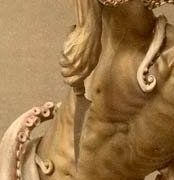2) Many photographs depicted long-died-out Japanese icons, such as Samurai and post men. Creating an album with these images would be a little different to an album with architecture because there is no way a Globetrotter would see a samurai, save for in a play. These images would serve as a reminder to the primitive and barbaric ways of Japanese life, which the GTs would take back home and show their families. The images exclude any instances of modernization, such as Japanese people in Western attire or factory workers, preferring to contain images of men in loincloths (like the postman) or other traditional Japanese clothing. The GTs did not want to show that Japan was exactly like the land they came from, so they highlighted images which do not look like the West, and those were the images which sold.
3) A Large majority (~65%) of Kimbei's images depicted women in man situations, starting from childhood and following through maturation and adulthood. These would be important to show how different Japanese life for women was than for Western women. There are very rarely photographs of men in any domestic setting, instead men are shown in traditional (and sometimes extinct) occupations. There was also a huge difference in the freedoms allowed to Japanese women than any other culture's women on the GTs trip, so they were privy to more aspects of domestic life than they would be in India or China. It's also interesting to note that Japan was ahead of the times on childhood and child rearing, while many Western cultures did not believe in childhood, and instead treated children as though they were adults. This could be interesting to GTs to have images of children at play or mothers caring for young children, because that was not a common occurrence in Europe.
This image is actually one of my favorites from the unit. We see a fisherman holding up a very primitive looking knife about to stab an octopus. The octopus has it's tentacles around the fisherman and is fighting back. The man is very muscled and is only wearing a loincloth. I first want to focus on the knife:
The knife looks like one you'd see in a museum for pre-historic tools. The knife is very rough, not smooth, and seems pretty brittle. Where the knife is positioned in reference to the octopus, the fisherman is most likely going to miss hitting him. The loincloth does not offer much protection against the octopus's suction cups, so an experienced fisherman would most likely be wearing a little more covering. This image is staged in a studio, so this man in not getting attacked for real. However, the danger of this barbarian stabbing his food to death would be very appealing to people.
GTs would buy this image because it shows a side of fishing they probably have no experience with. Unless the GTs came from Greece, they most likely would have never eaten/caught octopi for food, so this image would be jarring for them. This image would be especially appealing to fishermen who came to visit because it's a very dangerous image of their lively hood.
This image is funny because of what I talked about earlier. This child is crying and the caption is "Alone in a cold world." In Japan, this child would be well taken care of by its mother, and treated like it is a child. However, in Europe this sort of thing of letting your child "cry it out" would happen often. Having children as the focus for a lot of these images would be shocking to the Europeans who didn't really view children as any different than or more special than adults. The Japanese however realized early on how childhood is a separate entity from adulthood, and acted accordingly. This image could be an attempt to show something similar to the Europeans, since they already had the idea that the Japanese were pretty barbaric. Or, it could be an interesting image simply because the focus is solely on this child crying.




No comments:
Post a Comment